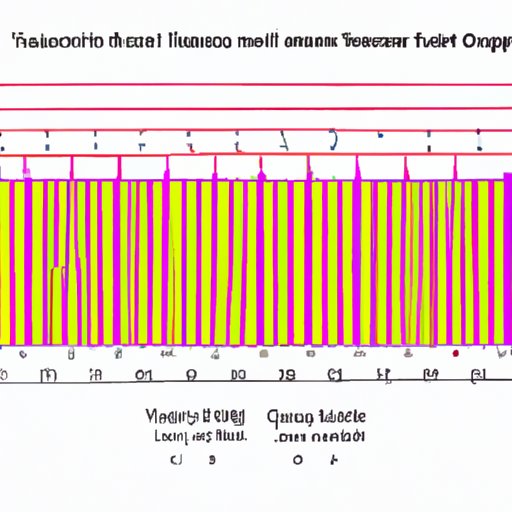
Introduction
Frequency is a fundamental concept in wave analysis, but understanding how to find frequency can be a confusing topic for beginners. In this article, we will explore the concept of frequency and its importance in wave analysis. We will cover different techniques and tips for accurately calculating and measuring wave frequency, as well as introduce the top tools and techniques for finding wave frequency. Additionally, we will delve into more advanced calculations for analyzing wave characteristics. Finally, we will discuss different units used to express frequency and how to convert between them.
Understanding Frequency: A Beginner’s Guide to Calculating Wave Frequency
Frequency is defined as the number of oscillations or cycles a wave completes in a second. It is typically measured in Hertz (Hz), with one Hz representing one cycle per second.
To calculate the frequency of a wave, we use the following formula:
Frequency = 1 / Time (T)
If the time to complete one cycle of the wave is measured in seconds, we can directly calculate the wave’s frequency by taking the inverse of the time.
For example, if a wave completes one cycle in 0.5 seconds, its frequency can be calculated as:
Frequency = 1 / T = 1 / 0.5 = 2 Hz
In essence, the frequency of a wave is just the reciprocal of the wave’s time period, which is the time it takes to complete one cycle.
It’s worth noting that frequency and wavelength are closely related. Wavelength is the distance between two adjacent peaks or troughs in a wave. The frequency and wavelength of a wave are inversely proportional to each other, meaning that as one increases, the other decreases.
Mastering Wave Frequency: Tips and Tricks for Accurately Measuring Wavelengths
Measuring the wavelength of a wave accurately is crucial for determining its frequency. One way to measure wavelength is to measure the distance between two adjacent peaks or troughs in the wave.
Using a ruler to measure distances manually is often the easiest and most straightforward method. However, this can be challenging for waves with small wavelengths or high frequencies. In such cases, it may be necessary to use specialized tools such as oscilloscopes or spectrometers to measure the wavelengths accurately.
One helpful tip for accurate measurement is to take the average of multiple measurements instead of relying on a single measurement. This can help reduce the impact of any errors or inaccuracies in the measurements.
Frequency Finders: The Top Tools and Techniques for Identifying Wave Frequencies
Various tools and techniques are available to measure wave frequency accurately. Oscilloscopes are one of the most common tools used to measure wave frequency. These devices display waves on a screen, making it easy to see the wave’s cycles and measure the frequency accurately using manual measurements or built-in frequency measurement tools.
Another useful tool for measuring frequency is a spectrum analyzer. This device is capable of analyzing a broad range of frequencies at once, making it ideal for identifying specific frequency bands or frequency spikes.
It’s important to note that different tools may have their advantages and disadvantages. Some tools can be more difficult to use than others, but might provide more accurate measurements. When selecting a tool, it’s essential to understand its limitations and choose the tool that is best suited for the particular task at hand.
Unlocking the Secrets of Wave Frequency: A Comprehensive Guide to Calculating and Analyzing Wave Characteristics
More advanced calculations are available to analyze wave characteristics, such as amplitude, phase, and frequency modulation. Amplitude refers to the height of the wave, while phase describes the angle between the wave and a reference point. Frequency modulation is when the frequency of the wave is varied, while the amplitude remains constant.
These concepts are used in various applications, including radio transmission and sound engineering. Understanding these advanced calculations can be helpful in analyzing and processing waves, but requires more in-depth mathematical knowledge.
From Hertz to Megahertz: Everything You Need to Know About Finding Wave Frequency
Frequency can be expressed in various units, including Hertz, kilohertz (kHz), megahertz (MHz), and gigahertz (GHz). The appropriate unit used to express frequency depends on the particular application. For example, radio waves often use MHz or GHz, while audio signals typically use Hz or kHz.
To convert between different units of frequency, we can use the following formulas:
- 1 kHz = 1000 Hz
- 1 MHz = 1000 kHz or 1,000,000 Hz
- 1 GHz = 1000 MHz or 1,000,000,000 Hz
These conversions are essential to communicate frequency measurements accurately across different applications.
Conclusion
Frequency is a fundamental concept in wave analysis, and understanding how to find frequency is essential for various applications. In this article, we covered the basics of wave frequency and explained the formula for calculating frequency. We also discussed various tools and techniques for measuring frequency accurately, including the use of oscilloscopes and spectrum analyzers. Additionally, we touched on more advanced concepts such as amplitude, phase, and frequency modulation. Finally, we provided an overview of the different units used to express frequency and discussed how to convert between them.
To truly master the art of analyzing waves, it’s essential to continue learning and exploring the different techniques, tools, and applications available. Understanding wave frequency is just the first step in unraveling the mysteries of the natural world around us.




